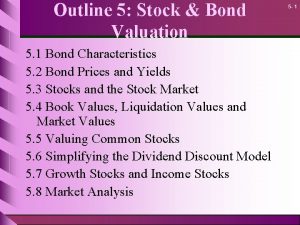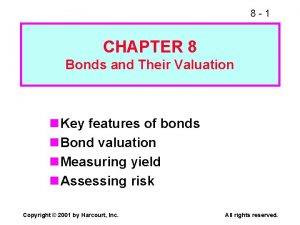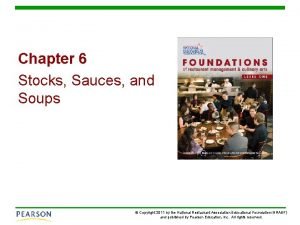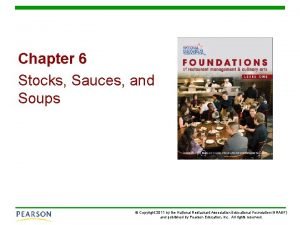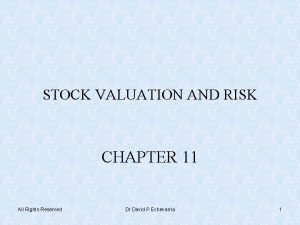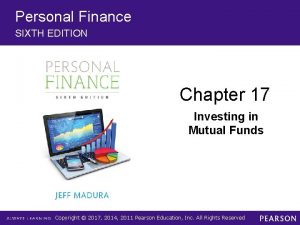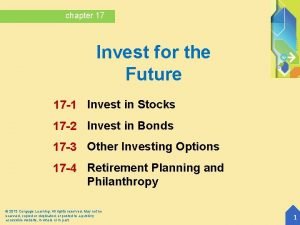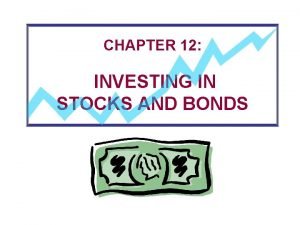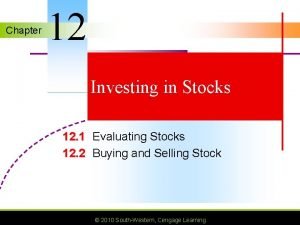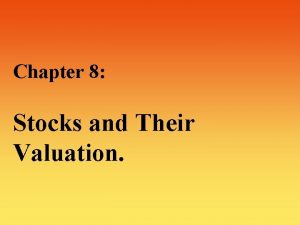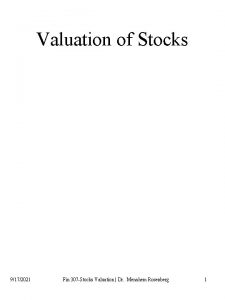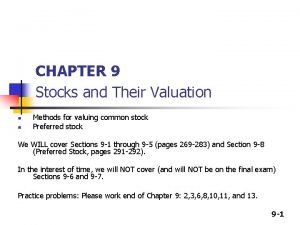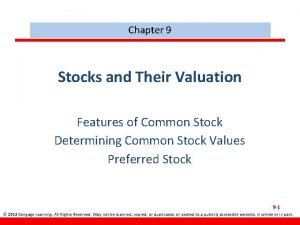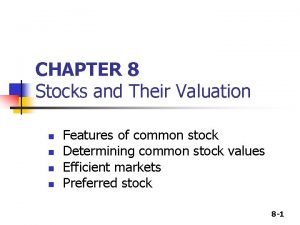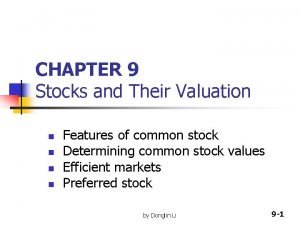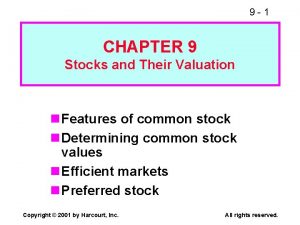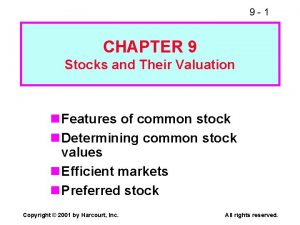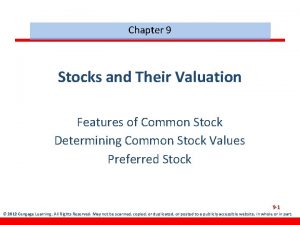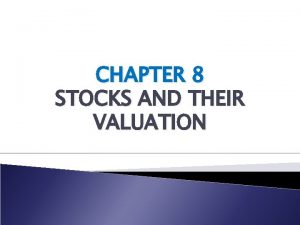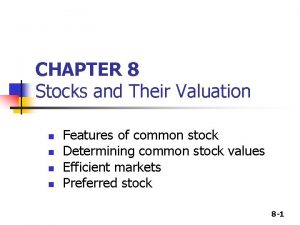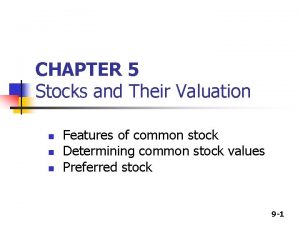Chapter 9 Stocks and Their Valuation 9 1














- Slides: 14

Chapter 9 Stocks and Their Valuation 9 -1 © 2013 Cengage Learning. All Rights Reserved. May not be scanned, copied, or duplicated, or posted to a publicly accessible website, in whole or in part.

Types of stock • Common stock – provides the permanent long-term financing of a firm – represents the true residual ownership of a firm – carries the right to vote on corporate policy and the composition of the board of directors Some facts about common stocks: • Represents ownership • Stockholders elect directors • Directors elect management • Management’s goal: Maximize the stock price • Preferred stock – carries no voting rights – has preference over common stock in the payment of dividends and claims on assets – usually has a fixed dividend. 9 -2 © 2013 Cengage Learning. All Rights Reserved. May not be scanned, copied, or duplicated, or posted to a publicly accessible website, in whole or in part.

Types of stock market transactions • - Secondary market: facilitate the trading of existing securities e. g. the sale of existing stock • - Primary market: facilitate the issuance of new securities e. g. , the sale of new corporate stock or new Treasury securities • Initial public offering (IPO) market (“going public”) 9 -3 © 2013 Cengage Learning. All Rights Reserved. May not be scanned, copied, or duplicated, or posted to a publicly accessible website, in whole or in part.

Intrinsic Value and Stock Price • Stock Price ->Current Market Price • Intrinsic Value -> “True” value based on it’s ability to generate cash now and in the future. • “Stock Price = Intrinsic Value” when market is at equilibrium – Stocks with a price below (above) its intrinsic value are undervalued (overvalued). 9 -4 © 2013 Cengage Learning. All Rights Reserved. May not be scanned, copied, or duplicated, or posted to a publicly accessible website, in whole or in part.

Cash flows to stockholders If you buy a share of stock, you can receive cash in two ways (i) Price appreciation/depreciation: You sell your shares either to another investor in the market. This constitutes the Capital gain/yield. (ii) Dividend payments: The price of the stock is the present value of these expected cash flows i. e. dividends. This constitutes the Dividend gain/yield. 9 -5 © 2013 Cengage Learning. All Rights Reserved. May not be scanned, copied, or duplicated, or posted to a publicly accessible website, in whole or in part.

Different Approaches for Estimating the Intrinsic Value of a Common Stock • • Discounted dividend model/Dividend growth Corporate valuation model 9 -6 © 2013 Cengage Learning. All Rights Reserved. May not be scanned, copied, or duplicated, or posted to a publicly accessible website, in whole or in part.

Discounted Dividend Model/Dividend Growth • Value of a stock is the present value of the future dividends expected to be generated by the stock. 9 -7 © 2013 Cengage Learning. All Rights Reserved. May not be scanned, copied, or duplicated, or posted to a publicly accessible website, in whole or in part.

Constant Growth Stock • A stock whose dividends are expected to grow forever at a constant rate, g. D 1 = D 0(1 + g)1 D 2 = D 0(1 + g)2 Dt = D 0(1 + g)t • If g is constant, the discounted dividend formula converges to Gordon Model: 9 -8 © 2013 Cengage Learning. All Rights Reserved. May not be scanned, copied, or duplicated, or posted to a publicly accessible website, in whole or in part.

Find the Expected Dividend Stream for the Next 3 Years and Their PVs D 0 = $2 and g is a constant 6%. 0 g = 6% 1. 8761 1. 7599 1 2 2. 12 2. 247 3 2. 382 rs = 13% 1. 6509 Using the constant growth model the stock’s intrinsic value is: 9 -9 © 2013 Cengage Learning. All Rights Reserved. May not be scanned, copied, or duplicated, or posted to a publicly accessible website, in whole or in part.

What is the stock’s expected value, one year from now? • D 1 will have been paid out already. So, expected P 1 is the present value (as of Year 1) of D 2, D 3, D 4, etc. • Could also find expected P 1 as: 9 -10 © 2013 Cengage Learning. All Rights Reserved. May not be scanned, copied, or duplicated, or posted to a publicly accessible website, in whole or in part.

Find Expected Dividend Yield, Capital Gains Yield, and Total Return During First Year • • Dividend yield = D 1/P 0 = $2. 12/$30. 29 = 7. 0% Capital gains yield = (P 1 – P 0)/P 0 = ($32. 10 – $30. 29)/$30. 29 = 6. 0% • Total return (rs) = Dividend yield + Capital gains yield = 7. 0% + 6. 0% = 13. 0% 9 -11 © 2013 Cengage Learning. All Rights Reserved. May not be scanned, copied, or duplicated, or posted to a publicly accessible website, in whole or in part.

What would the expected price today be, if g = 0? The dividend stream would be a perpetuity. 0 rs = 13% 1 2 3 2. 00 9 -12 © 2013 Cengage Learning. All Rights Reserved. May not be scanned, copied, or duplicated, or posted to a publicly accessible website, in whole or in part.

Corporate Valuation Model • Also called the free cash flow method. Suggests the value of the entire firm equals the present value of the firm’s free cash flows. • This model is used as an alternative to the discounted dividend model to determine a firm’s value, especially one with no history of dividends. • This model first calculates the firm’s expected free cash flows, then finds their present values to determine the firm’s value. 9 -13 © 2013 Cengage Learning. All Rights Reserved. May not be scanned, copied, or duplicated, or posted to a publicly accessible website, in whole or in part.

Preferred Stock • Hybrid security. • Like bonds, preferred stockholders receive a fixed dividend that must be paid before dividends are paid to common stockholders. • However, companies can omit preferred dividend payments without fear of pushing the firm into bankruptcy. • If preferred stock with an annual dividend of $5 sells for $50, what is the preferred stock’s expected return? 9 -14 © 2013 Cengage Learning. All Rights Reserved. May not be scanned, copied, or duplicated, or posted to a publicly accessible website, in whole or in part.
 Pvgo example
Pvgo example Fixed income valuation
Fixed income valuation Bonds and their valuation
Bonds and their valuation A flavorful liquid made by gently simmering bones
A flavorful liquid made by gently simmering bones Chapter 6 stocks sauces and soups
Chapter 6 stocks sauces and soups Chapter 6 stocks sauces and soups
Chapter 6 stocks sauces and soups Chapter 6 stocks sauces and soups
Chapter 6 stocks sauces and soups Chapter 6 stocks sauces and soups
Chapter 6 stocks sauces and soups Dr david echevarria
Dr david echevarria Chapter 17 investing in stocks
Chapter 17 investing in stocks Chapter 17 investing in stocks
Chapter 17 investing in stocks Chapter 12 investing in stocks
Chapter 12 investing in stocks Chapter 12 investing in stocks
Chapter 12 investing in stocks Chapter 11 stocks
Chapter 11 stocks Stored sauces and starches in a
Stored sauces and starches in a
